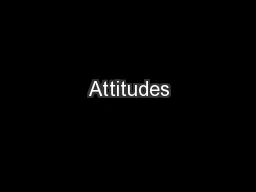

What is an attitude What do we have attitudes on Where do attitudes come from Dispositional attitudes Hepler amp Albarracin 2013 APE Model Gawronski amp Bodenhausen 2014 ID: 459432
Download Presentation The PPT/PDF document "Attitudes" is the property of its rightful owner. Permission is granted to download and print the materials on this web site for personal, non-commercial use only, and to display it on your personal computer provided you do not modify the materials and that you retain all copyright notices contained in the materials. By downloading content from our website, you accept the terms of this agreement.
Slide1
AttitudesSlide2
What is an attitude?
What do we have attitudes on
? At what level?
What are the components of an attitude?
Where
do attitudes come from?
Are they implicit or explicit?
Are they stored in memory?
Is
there one or more than
one for any object?
What do they do for us?
Do these studies replicate?
Are they related to our biology? Slide3
Heritability/Biology
Tesser
, 1993
http
://
citeseerx.ist.psu.edu/viewdoc/download?doi=10.1.1.397.3326&rep=rep1&type=pdf
Olson, Vernon, Harris, & Lang, 2001
https://
psycnet.apa.org/fulltext/2001-06600-001.pdf
Hepler
&
Albarracin
, 2013
https://
psycnet.apa.org/fulltext/2013-13270-001.pdf
Evolutionary
influences
e
.g.,
Petersen,
Sznycer
, Sell,
Cosmides
, &
Tooby
, 2013Slide4
History of research on persuasion
Attitudes as social psych’s “most indispensable concept”
Hovland
, WW2 researchers (50s, 60s)
Who said what to whom
Learning
principles
Sleeper effect
Festinger
,
1957 (and later motivated reasoning,
Kunda
, 90)
Cognitive dissonance theory
“New looks” of dissonance
Sherif
&
Sherif
, 1967
Social judgment theory
Greenwald, Petty,
Ostrom
, Brock (80s)
Cognitive response approach
Thoughts elicited
matter
Tesser
—thought-induced attitude changeSlide5
Harton, 1998 (based on
Latané
& Nowak, 1994)Slide6
ELM (Petty & Cacioppo
, 1986)
What does the ELM predict?
Central vs. peripheral route
What determines persuasion in high vs. low EL situations?
Senior comprehensive exam paradigm
How do attitudes formed or changed through central vs. peripheral differ?
Heuristic-systematic
model (
Eagly
&
Chaiken
, 1986)Slide7
Modifications/add ons
to ELM
Discrepancy Motives Model (Clark & Wegener, 2013)
Meta-cognitive model (Petty,
Brison
,
Tormala
, & Wegener, 2007)
Target, origin, valence, amount
Self-validation hypothesis Petty &
Brinol
(2006)
Thoughts
matter more when confidence in them
Nodding
headSlide8
Variables affecting persuasion
Source factors
Message factors
Recipient factors
Matching factorsSlide9
CAN Model (Dalege
et al., 2016)
What does this model add
?
What is the problem with the initial idea of the tripartite structure of attitudes and with how people current talk about it?
What is a parallel constraint satisfaction model?
Small world structure? Figure
1Slide10
What does this model suggest about how to persuade people?
What is attitude strength, according to this model?
What
are the implication of the CAN model for attitude measurement?
How does this link to CTA? Dynamic systems? Attractors? Slide11
Attitude Roots (
Hornsey
& Fielding, 2017)
What is new in this approach?
What are the “roots” they mention? Are there others you can think of? What else are these concepts similar to? Table 1
Why doesn’t more evidence work?
How do you change attitudes, according to this approach?
Do these roots affect scientists too? Slide12
Attitudes and behavior
LaPiere
, 1934
Wicker, 1969
Why might attitudes not predict behavior?
When do attitudes predict behavior?
Measurement issues
Accessibility (Fazio, 1990) MODE model
Attitude strength approaches
Individual difference approaches
Theory of reasoned action (
Fishbein
&
Ajzen
, 1980)
Theory of planned behavior (
Ajzen
, 1991)
Implicit vs. explicit attitudes? Slide13
Theory of Planned behavior (
Ajzen
, 2006)Slide14
TRA and goals (
Ajzen
&
Kruglanski
, 2019
)
Theory of reasoned goal pursuit
What
does this approach add?
What
determines what goal is active?
How do we measure what people’s goals will be for TRGP
?
What is the difference between procurement goals and approval goals? How do they add to the model? Slide15
TRGP
How related are behavioral intentions to behavior? Why is it not 100%?
Are TPB and TRGP automatic or controlled?
Figure 1—how does it differ from TPB? Slide16
Overview
When will
attitude
change be more stable?
CAN model
ELM
CTA
Roots
When
will attitudes be more likely to affect behavior?
ELM
TPB
CAN
TRGPSlide17
Discussion
Elaboration Likelihood Model
CAN model
Attitud
e roots
Convince people to donate to hurricane relief
Convince people to vote for your candidate